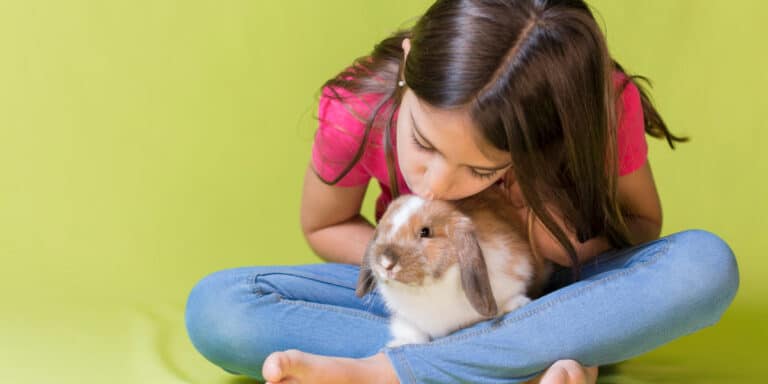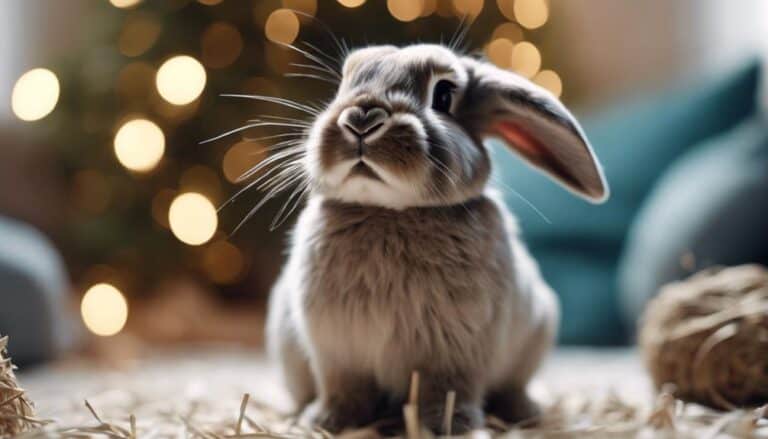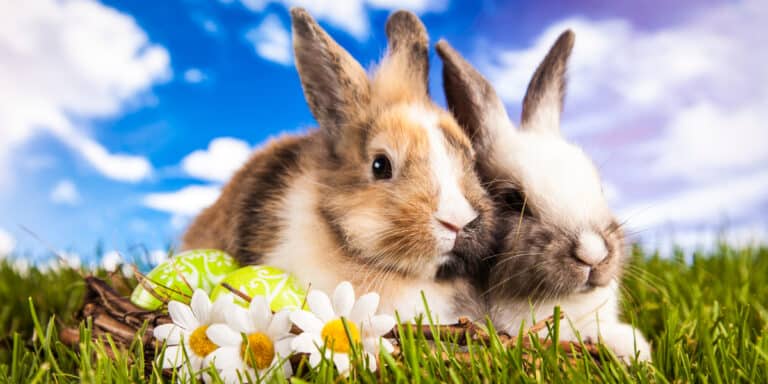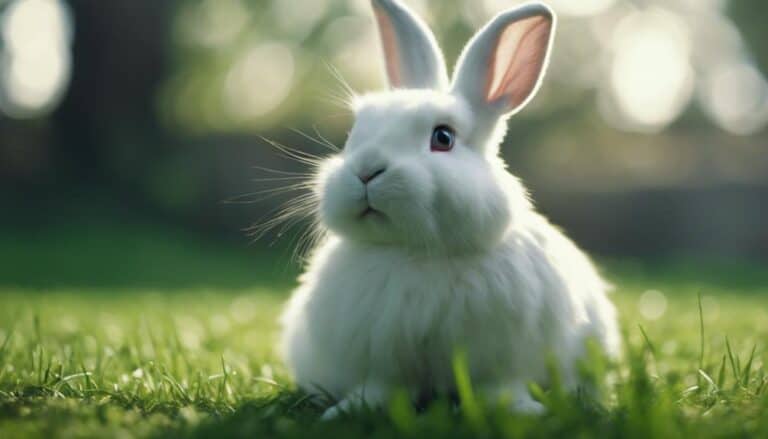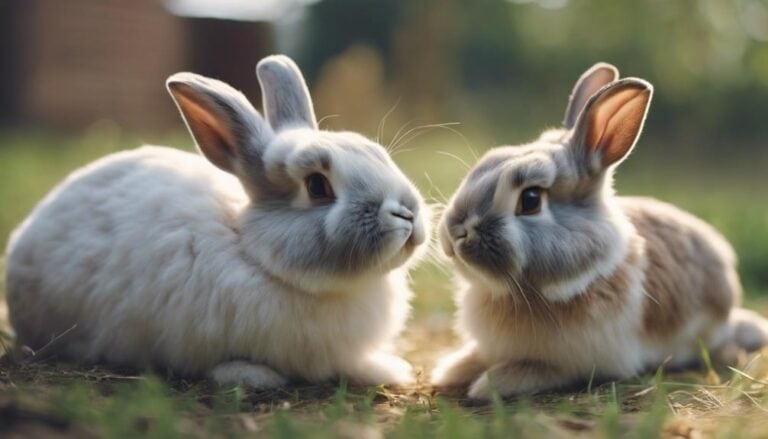When bonding bunnies, approximately 60% of rabbit pairs will engage in some form of conflict before establishing a bond. This may seem like a common occurrence, but there is an intriguing aspect to ponder. Do bunnies always fight before bonding, or is there more about this process than meets the eye? Understanding the dynamics of bunny behavior and the intricacies of their interactions can shed light on whether conflict is an inevitable precursor to forming a lasting bond.
It's essential to observe their interactions carefully and provide a safe environment for them to establish their relationship. By understanding their behavior and giving them the necessary support, you can help them navigate the bonding process successfully.
Contents
- 1 Key Takeaways
- 2 Bunny Bonding Process Overview
- 3 Initial Bunny Interactions
- 4 Establishing Neutral Territory
- 5 Observing Positive Bunny Behavior
- 6 Signs of Successful Bunny Bonding
- 7 Addressing Bunny Disagreements
- 8 Transitioning Bunnies to Shared Space
- 9 Ensuring Long-Term Bunny Harmony
- 10 Frequently Asked Questions
- 11 Is Fighting a Normal Part of the Bonding Process for Bunnies?
- 12 Conclusion
Key Takeaways
- Bunny bonding involves territorial behaviors like chasing and mounting.
- Initial scuffles and nips help establish hierarchy and boundaries.
- Neutral territory reduces conflicts and encourages positive interactions.
- Positive interactions like grooming and play indicate progression in bonding.
Bunny Bonding Process Overview
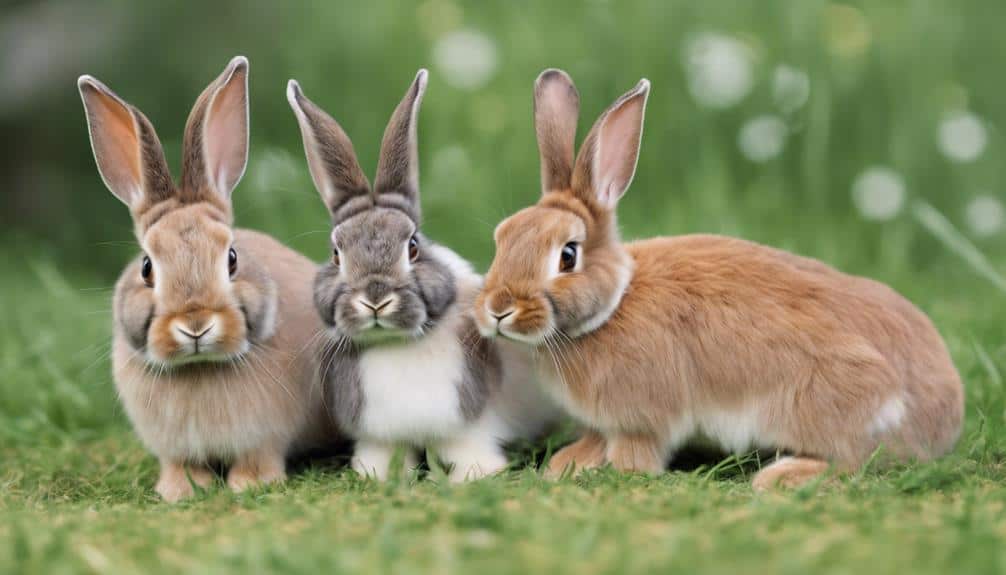
When beginning the bonding process between bunnies, it's essential to understand the behaviors they may exhibit, such as nipping, mounting, and chasing. These actions are part of their natural instincts to establish dominance and hierarchy within their group.
In the initial bonding stages, one bunny may display dominance by mounting or nipping at the other, while the submissive bunny may try to avoid confrontation by running away or hiding. To facilitate a smoother bonding process, it's advisable to introduce the bunnies in a neutral area where neither one feels the need to defend their territory. This neutral space can help reduce initial conflicts and create a more relaxed environment for the bunnies to interact.
Initial Bunny Interactions
During the initial interactions between bunnies, it's common for territorial behaviors like chasing or mounting to be displayed as they work towards establishing a bond. Here are some key behaviors you may observe:
- Territorial Behaviors: Bunnies may exhibit territorial behaviors such as chasing or mounting as they establish their boundaries within the shared space.
- Scuffles and Nips: Minor scuffles or nips can occur as bunnies negotiate their hierarchy and boundaries during the bonding process.
- Playful Behaviors: Keep an eye out for playful behaviors like grooming or sniffing, which indicate a positive interaction and progression towards a bond.
Establishing Neutral Territory
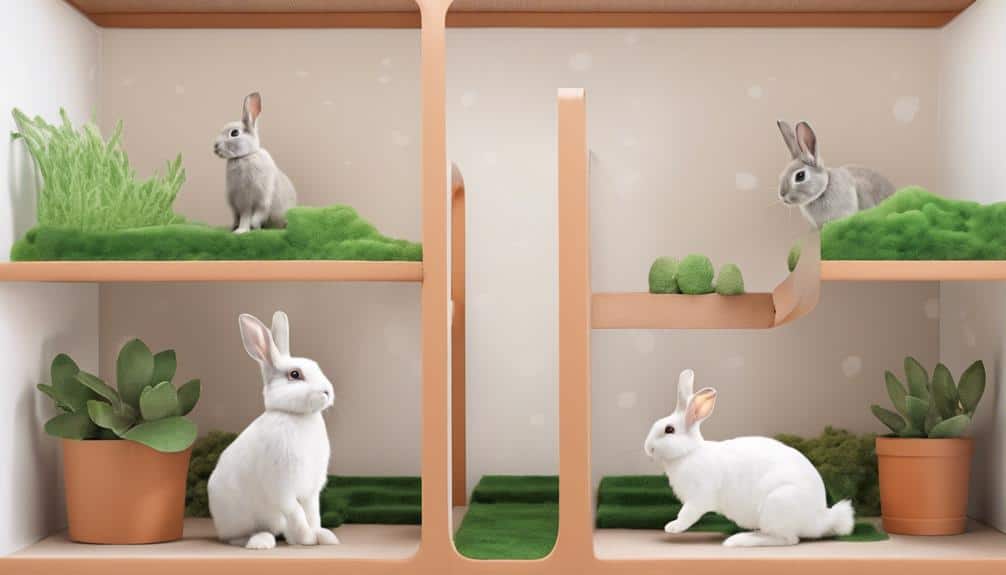
When introducing your rabbits, establishing neutral territory is key. This step helps reduce territorial behavior and allows for a smoother bonding process.
Neutral Space Importance
Establishing neutral territory is an important step in the bonding process between rabbits to prevent territorial aggression. When introducing rabbits, using a neutral space is vital to ensure a smooth interaction. Here's why neutral space is essential:
- Minimizes Fights: Neutral spaces like a bathtub or a playpen help reduce conflicts by eliminating existing territorial scents.
- Encourages Focus: A neutral environment allows rabbits to concentrate on each other rather than defending their territory.
- Promotes Positive Interaction: Providing a neutral territory enables rabbits to explore and engage without feeling threatened, fostering a positive initial interaction.
Neutral spaces play a significant role in establishing harmony between rabbits during the bonding process.
Encouraging Initial Interactions
Encouraging initial interactions in a neutral space facilitates a smooth introduction between bunnies, promoting positive associations and minimizing conflicts. Placing bunnies in a neutral territory, such as a bathtub or playpen, allows them to acclimate to each other's presence without feeling threatened.
Introducing toys or items of interest in this space can serve as distractions, encouraging bunnies to explore and interact with each other positively during their first meeting. Offering treats or favorite foods within the neutral area can help create positive associations and entice the bunnies to engage with one another without displaying aggression.
Monitoring Body Language
To effectively monitor body language when bonding bunnies in neutral territory, pay close attention to cues like relaxed body postures and ear positions. Here are some key points to help you navigate the bonding process:
- Look for signs of relaxation such as flopping or grooming, indicating positive interaction.
- Ears positioned forward demonstrate curiosity and interest in bonding.
- Beware of tense body postures and ears laid back, as they may signal aggression or discomfort.
Observing Positive Bunny Behavior
When observing positive bunny behavior, look for grooming sessions and playful interactions, as these activities encourage bonding between bunnies.
Playful behaviors like chasing and hopping together can indicate a developing connection and a positive relationship forming.
Keep an eye out for shared grooming, mutual exploration, synchronized movements, and calm body language as signs of a growing bond between your bunnies.
Bonding Through Grooming
Observing rabbits groom each other provides valuable insight into the positive bonding and affectionate relationships developing between them. When rabbits engage in grooming behaviors, they're actively building a strong bond as a bonded pair.
Mutual grooming helps establish a clear social hierarchy within the group, fostering a sense of security and order. Reciprocal grooming, such as licking, nibbling, and cleaning each other's fur, is a common sign of bonding between rabbits. This form of communication not only strengthens their relationship but also indicates trust and affection.
Playful Interactions Encourage Bonding
Encouraging playful interactions between rabbits is key to fostering bonding and positive behavior in their relationship. Playful interactions such as mutual grooming, sharing food, and playful chasing indicate a growing bond between bunnies.
When bunnies snuggle or lie down next to each other, it shows comfort and trust developing in their bond. Observing relaxed body language, like flopping or stretching out, signifies a positive connection forming between bunnies.
Positive bunny behavior also includes exploring together and engaging in activities that bring them joy, like binkying. By promoting these playful interactions and observing the signs of a budding bond such as snuggling and mutual grooming, you can help create a strong and harmonious relationship between your bunnies.
Signs of Successful Bunny Bonding
To gauge successful bunny bonding, look for positive behaviors such as grooming, nuzzling, and snuggling. These signs indicate that your bunnies have bonded well and are comfortable with each other. Here are three key indicators that your bunnies have successfully bonded:
- Established Trust: Bunnies that have bonded will engage in shared activities, such as exploring their space together and engaging in synchronized behaviors. This mutual trust is a strong foundation for a lasting bond.
- Relaxed Body Language: Pay attention to your bunnies' body language. A successful bond is often accompanied by relaxed postures, indicating that they feel safe and comfortable in each other's presence.
- Affectionate Behavior: Mutual grooming, synchronized eating, and calm cohabitation are signs of a well-bonded bunny pair. If your bunnies seek each other's company, show affection, and exhibit relaxed body language, it's a good indication that they've formed a harmonious bond.
Addressing Bunny Disagreements
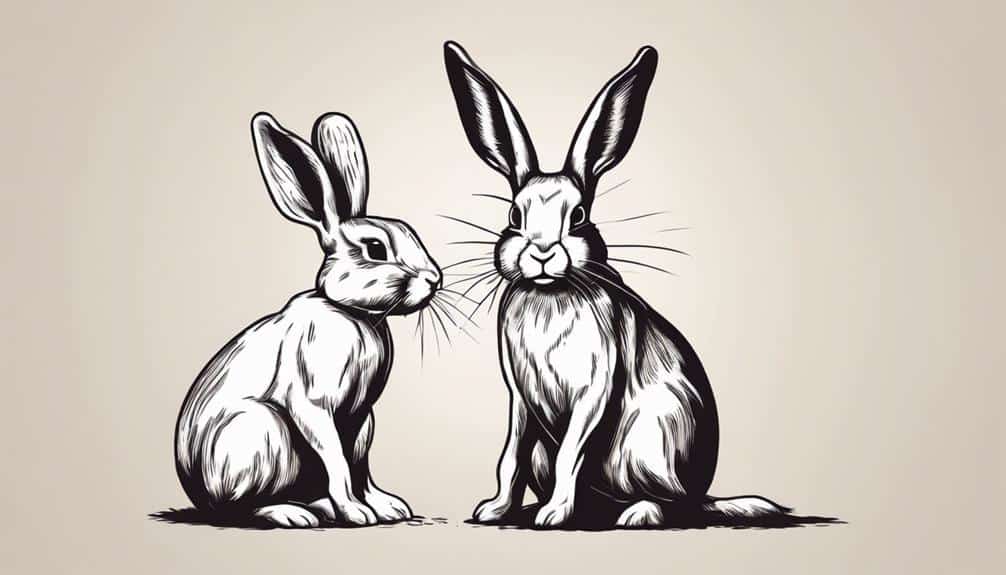
During the bonding process, addressing bunny disagreements is essential to ensuring a successful and harmonious relationship between your rabbits. These social creatures often engage in behavior that establishes a pecking order, with one rabbit emerging as the dominant one.
While mild scuffles, nips, and chasing are normal during the bonding process, it's vital to monitor these interactions closely. Playful interactions can sometimes escalate into more serious fights, necessitating your intervention to prevent injuries.
Recognizing the difference between playful behavior and true aggression is key to facilitating a positive bond between your bunnies. By actively supervising their interactions and stepping in when necessary, you can help guide them towards a healthier relationship.
Addressing bunny disagreements during the bonding process involves closely monitoring interactions to distinguish between playful behavior and true aggression, ensuring a successful and harmonious relationship between your rabbits.
When moving bunnies to shared space, follow these essential steps:
- Gradual Introductions: Begin by allowing the bunnies to interact in neutral territory to prevent territorial behavior and fights.
- Supervised Playdates: Organize supervised playdates in a safe, enclosed area to facilitate positive interactions and minimize the risk of aggression.
- Monitoring Body Language: Pay close attention to the bunnies' body language and behavior cues during the transfer phase. This helps gauge their comfort levels and readiness for shared space.
Ensuring Long-Term Bunny Harmony
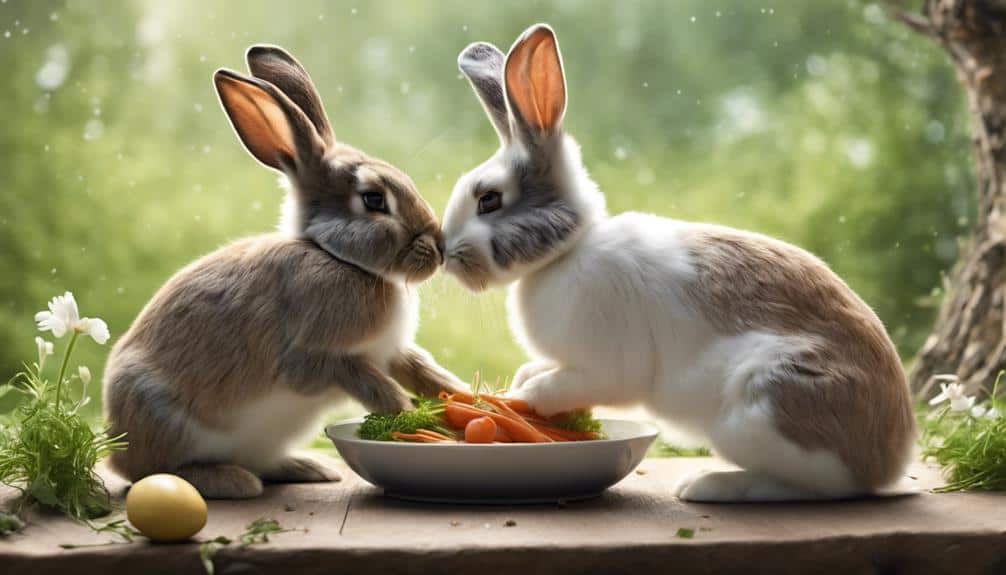
Establishing long-term bunny harmony involves gradually bonding your rabbits to build trust and companionship over time. The bonding process requires giving your bunnies the space and time to adjust, communicate through scent, sight, and gentle interactions. Positive interactions such as sharing food, grooming, and snuggling are indicators of progressing towards a vital bond.
Creating a safe and enriched environment with ample space and resources is critical for fostering a healthy relationship between your bunnies. Consistency, patience, and monitoring interactions closely are key elements in maintaining long-term bunny harmony.
Frequently Asked Questions
How Do You Bond Rabbits When One Is Aggressive?
To bond rabbits when one is aggressive, address the root cause of aggression, seek professional guidance, introduce them gradually, use positive reinforcement, and monitor interactions closely. By handling aggression with care, you can foster positive interactions and build trust.
How Do You Know if Rabbits Are Not Bonding?
To tell if rabbits aren't bonding, observe their body language for signs like lack of grooming or nipping. Guarantee they meet in neutral territory, introduce slowly, encourage positive interactions, use time outs if needed, and seek professional help when necessary.
When Should You Stop a Rabbit From Fighting?
When should you stop a rabbit from fighting? Recognize escalating aggression. Intervene using behavior modification, observe body language signals, establish trust, and implement separation protocol. Socialization strategies can help create harmony. Your role is vital in fostering a safe environment.
What Are Good Signs When Bonding Rabbits?
When bonding rabbits, look for positive body language like relaxed ears and soft eyes. Mutual grooming, nuzzling, and shared meals are good signs. Playful behaviors such as binkying and chasing without aggression indicate a strong bond forming.
Is Fighting a Normal Part of the Bonding Process for Bunnies?
When it comes to bonding bunnies, behavior communication through fighting can be a normal part of the process. This can help establish dominance and hierarchy within the group. However, it’s important for owners to closely monitor the situation and intervene if the fighting becomes too aggressive.
Conclusion
Congratulations!
While it's common for bunnies to fight before bonding, not all will follow this path. Remember, conflict isn't always a prerequisite for a strong bond.
By understanding their behavior, providing the right environment, and closely monitoring interactions, you can facilitate a harmonious relationship between your bunnies.
Embrace the irony that sometimes, peace can be achieved without a single paw raised in aggression.

